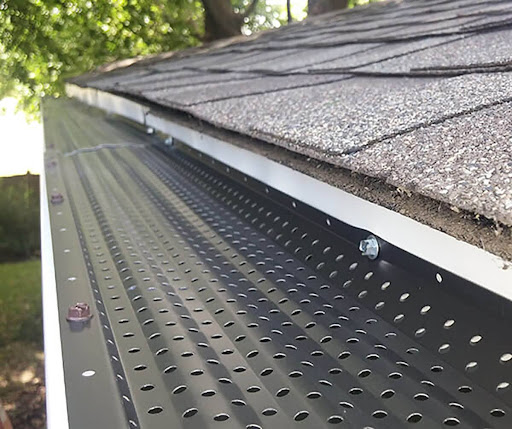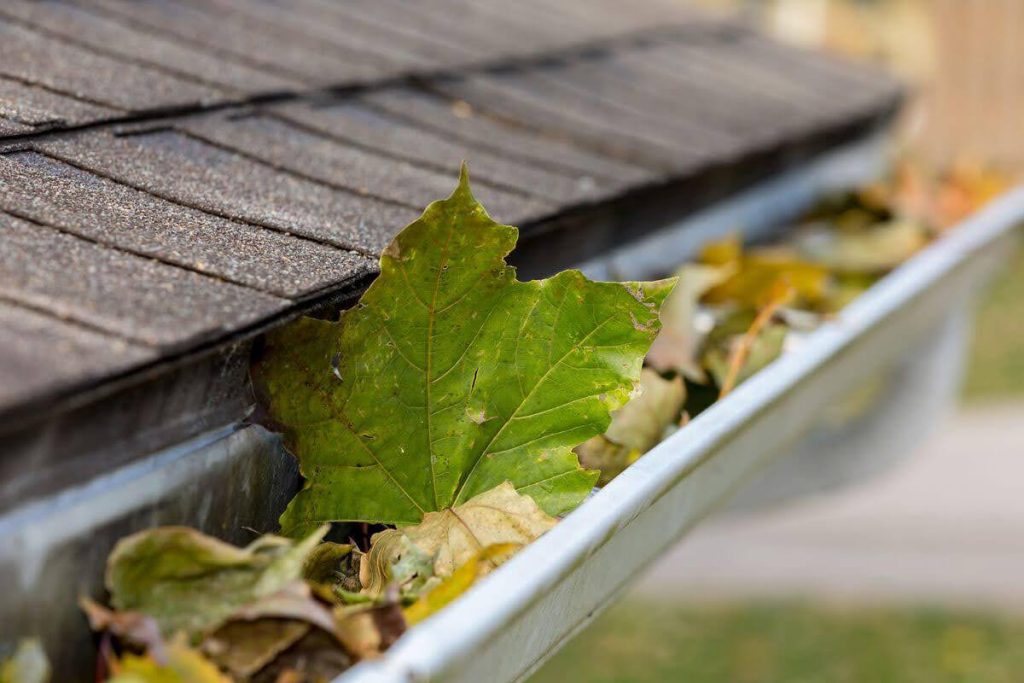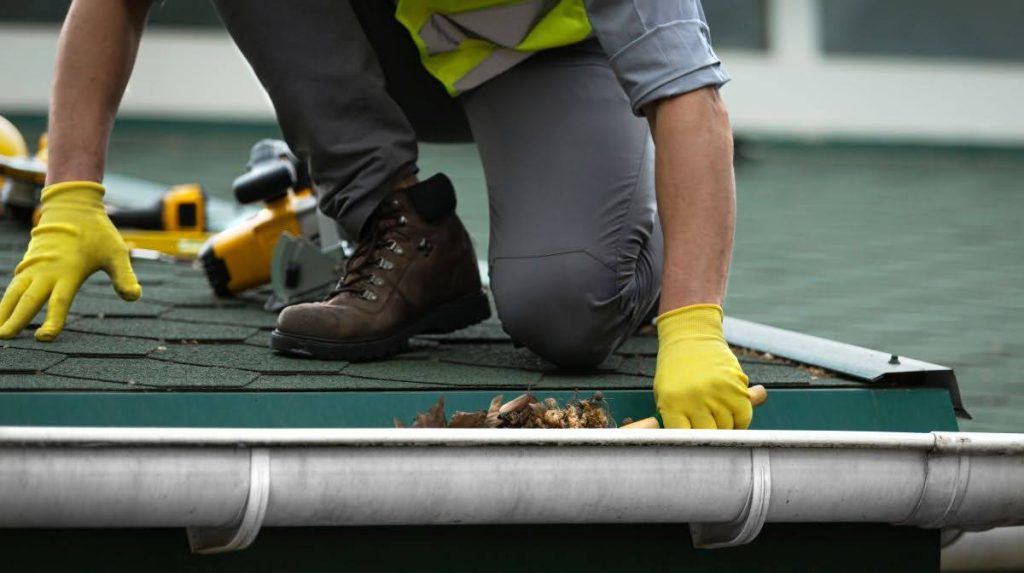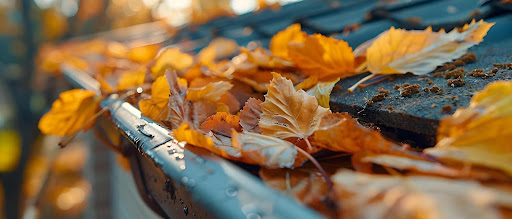With the arrival of fall, the importance of keeping your gutters clean cannot be overstated. Falling leaves can quickly clog your gutters, leading to potential water overflow, roof damage, and even foundation problems.
In this comprehensive guide, we will walk you through the essential steps to effectively remove leaves in gutters. From the tools you’ll need to the best practices for safe and efficient cleaning, we’ve got you covered!
How to Remove Leaves From Gutters
Looking for the best way to clean leaves out of gutters? Here are a few tried-and-true methods to get you started!
Manual Removal
- Gather Your Tools: You’ll need a sturdy ladder, gloves, a bucket or bag, and a gutter scoop or small trowel.
- Set Up Safely: Place your ladder on a stable, level surface. Ensure it is securely positioned before climbing.
- Start Scooping: Begin at the downspout and work your way towards the opposite end. Use the gutter scoop to remove leaves and debris, placing them into your bucket or bag.
- Flush the Gutters: Once the bulk of the debris is removed, use a garden hose to flush out any remaining dirt and check for proper water flow.
When using ladders, always have someone hold the ladder for added stability. Avoid overreaching and move the ladder as needed to stay safe. Additionally, wear non-slip shoes and consider using a ladder stabilizer.
Using a Leaf Blower
- Choose the Right Attachment: Use a gutter cleaning attachment designed for leaf blowers.
- Position the Blower: Start at the downspout and blow the leaves towards the opposite end.
- Work in Sections: Clear small sections at a time to ensure thorough cleaning.
Using a leaf blower to clear leaves in gutters is quick and efficient (especially for dry leaves) and reduces the need for ladder use. However, this method can be messy, as leaves may scatter, and it is less effective for wet or compacted debris.
Wet/Dry Vacuum
- Set Up the Vacuum: Attach the appropriate hose and nozzle for gutter cleaning.
- Vacuum the Debris: Start at the downspout and work your way along the gutter, vacuuming up leaves and debris as you go.
- Check for Blockages: Periodically check the vacuum hose for clogs and clear them as needed.
For the best results, use a vacuum with a powerful motor to handle both wet and dry debris. Make certain the vacuum is placed on a stable surface to prevent tipping.
Essential Equipment for Cleaning Leaves in Gutters
Ladders
Extension ladders are ideal for reaching high gutters on multi-story homes, while step ladders are suitable for single-story homes or lower gutters. For added stability, consider using a ladder with a wide base or one equipped with stabilizing bars.
Ladder Safety Tips
- Always place the ladder on a stable, level surface to prevent tipping.
- Ensure the ladder is fully extended and locked before climbing.
- While on the ladder, maintain three points of contact (two hands and one foot, or two feet and one hand).
- Avoid overreaching; instead, move the ladder as needed to stay safe.
- Have someone hold the ladder for added stability, especially if you’re working at significant heights.
Protective Gear
Gloves will protect your hands from sharp debris, insects, and potentially harmful substances. Similarly, safety glasses shield your eyes from dirt or any splashes you may encounter during cleaning.
Wearing long sleeves and pants can protect your skin from scratches and irritants. Non-slip shoes are also recommended to provide better footing on ladders.
Gutter Cleaning Tools
- Gutter Scoops: These are designed to fit the shape of gutters, making it easier to scoop out leaves and debris.
- Gutter Tongs: Long-handled tongs allow you to grab debris from the ground or a ladder, ideal for hard-to-reach areas.
- Telescoping Wands: Attach these to a garden hose or pressure washer to clean gutters from the ground.
Buckets and Tarps
Using buckets and tarps helps you manage debris while maintaining a clean work area. Start by hanging a bucket from your ladder to collect debris as you scoop it out of the gutters; this minimizes the mess and makes disposal much easier.
You could also choose to spread a tarp on the ground below your work area to catch any falling debris. This not only keeps your yard clean but also makes cleanup more efficient. Once you’re done, simply fold up the tarp and dispose of the collected debris.
How to Keep Leaves Out of Gutters

You might be asking how to prevent leaves in gutters from the start. There are several methods you should consider to maintain a fully functional gutter system.
Gutter Guards
There are several types of gutter guards available to help prevent the build-up of leaves in gutters.
Drop-in gutter guards are designed to sit on top and attach to the gutter. They are made of perforated aluminum sections that prevent moderate to large debris from clogging the gutter system. Leaves tend to collect on this type of gutter protection but generally blow off with light wind. These are easy to install and cost-effective but require routine maintenance.
Micro mesh gutter guards feature a mesh screen that covers the gutter, allowing water to pass through while blocking leaves and debris. Mesh models are particularly effective at keeping out small debris; they are additionally easy to install and relatively affordable. However, they can become clogged with fine debris over time, requiring occasional cleaning.
Helmet-style gutter guards are designed with a bull-nosed shape that directs water into the gutter while debris falls to the ground. These guards are highly effective at keeping out large debris and require low maintenance. On the downside, they are more expensive.
Regular Maintenance
Even with gutter guards in place, regular maintenance is key to ensuring your gutters remain clear and functional.
Inspections help identify potential issues early — such as gutter clogs or sagging gutters — which can prevent costly repairs down the line. We suggest having your gutters inspected in both spring and fall to remove any debris that accumulated over the prior seasons.
We further advise checking your gutters for any debris or gutter damage following heavy storms and high winds in your area.
Trimming Trees
Trimming trees near your home can significantly reduce the amount of leaves in gutters. By keeping branches away from your roofline, you minimize the risk of leaves, twigs, and other debris clogging your gutters.
For regular pruning, trim back branches that overhang your roof or are within proximity to your gutters. Seasonal maintenance should be performed, as well — ideally in late winter or early spring before new growth begins. For large trees or branches near power lines, consider hiring a professional arborist to ensure safe, effective trimming.
Types of Leaves That Pose the Greatest Nuisance in South Jersey
With its diverse array of trees, South Jersey experiences a significant leaffall each autumn. While the changing colors are a sight to behold, the aftermath can be quite a nuisance for homeowners!
Oak Leaves
Oak trees are abundant in South Jersey, and their leaves are known for their tough, leathery texture. These leaves are particularly problematic because they are slow to decompose. When they fall, they tend to form thick layers that can smother grass and other plants, preventing sunlight and moisture from reaching the soil.
Additionally, oak leaves can be cumbersome to rake and collect due to their size. If left unattended, they can create a dense mat that is difficult to manage (and may potentially harbor pests).
Maple Leaves
Maple trees, with their broad and vibrant leaves, are another common sight in South Jersey. While beautiful, these leaves can quickly become a homeowner’s nightmare when they start to fall; Maple leaves are notorious for clogging gutters and downspouts.
Their large surface area allows them to easily block drainage systems, leading to water overflow and potential damage to the home’s foundation or roof. Regular maintenance is essential to prevent these issues, as clogged gutters can also become a breeding ground for mold and mildew.
Pine Needles
Pine needles present a unique set of challenges compared to broadleaf trees. These slender, needle-like leaves can infiltrate even the smallest crevices, making them particularly difficult to clean up. Pine needles commonly accumulate in gutters, on roofs, and in garden beds, creating a fire hazard if they dry out. Their acidic nature also alters the pH of the soil, affecting plant growth.
Pine needles have the potential to form a slippery layer on walkways and driveways, posing a safety risk.
Other Common South Jersey Leaves
Apart from oak, maple, and pine, South Jersey is home to a variety of other trees whose leaves can cause problems. Sycamore leaves, for instance, are large and can quickly cover lawns, making cleanup a daunting task.
Birch leaves, though smaller, accumulate in large numbers and create a mess in gardens and on patios.
Sweetgum trees drop not only leaves but also spiky seed pods that can be a pain to collect and can cause injury if stepped on. Each type of foliage brings its own set of challenges, requiring diligent maintenance to keep properties clean.
Leaves in Gutters: Problems and Risks

Neglecting this essential maintenance task can lead to a host of problems that may ultimately compromise the integrity of your home.
Water Damage
Of course, one of the most immediate risks of having leaves in gutters is water damage. When gutters are blocked by leaves or other debris, they can’t effectively channel rainwater away from your home.
This can result in water overflowing and seeping into your walls, windows, and ceilings. Over time, this excess moisture leads to mold growth, wood rot, and structural damage. The cost of repairing water damage can be substantial, making regular gutter maintenance a wise investment.
Pest Infestations
Unfortunately, clogged gutters provide an ideal environment for pests. The accumulation of leaves — combined with stagnant water — creates a perfect breeding ground for mosquitoes, while the damp, sheltered conditions attract rodents, birds, and insects.
These pests can cause further damage by gnawing on your home’s structure, nesting in your attic, or even finding their way into your living spaces. Beyond merely being a nuisance, pest infestations pose health risks to your family.
Foundation Issues
When water overflows from gutters, it can pool around the base of your home. Excess moisture erodes the soil and weakens the foundation, leading to cracks and instability.
In severe cases, foundation damage may compromise the structural integrity of your home, resulting in costly repairs. Ensuring that your gutters are clear and functional is essential for protecting your home’s foundation.
Roof Damage
When water can’t flow freely through the gutters, it backs up under the roof shingles, leading to leaks and water damage in the attic. The constant exposure to moisture can also cause the fascia boards and soffits to rot, compromising the overall structure of your roof.
In winter, clogged gutters contribute to the formation of ice dams, which can further damage your roof and result in costly repairs.
How Often Should Gutters Be Cleared Out?
The answer depends on several factors, including the season and the density of trees around your home.
Seasonal Recommendations
- Spring: After the winter months, gutters can be filled with debris such as leaves, twigs, and even ice remnants. A thorough cleaning in early spring ensures that your gutters are ready to handle the spring rains. Aim to clean your gutters at least once during this season.
- Summer: While summer generally sees less leaffall, it’s still important to check your gutters, especially after storms. Heavy rains or winds often deposit leaves in gutters. A mid-summer inspection and cleaning can help prevent any buildup.
- Fall: With leaves falling in abundance, gutters quickly become clogged. Depending on the number of trees around your home, you may need to clean your gutters multiple times during the fall season. A good rule of thumb is to clean them at the beginning, middle, and end of fall.
- Winter: In winter, the focus shifts to preventing ice dams and making certain that your gutters are free of debris; during the colder months, they can freeze and cause blockages. A pre-winter cleaning is essential to prepare your gutters for the cold months. From that point on, periodic checks during winter will help you catch and address any issues early.
Other Factors Affecting Cleaning Frequency
- Tree Density: The number and type of trees around your home significantly impact how often you need to clean your gutters. Homes surrounded by deciduous trees will require more frequent cleaning, especially in the fall. Evergreen trees, while not shedding leaves, can still drop needles and other debris.
- Roof Type and Slope: The design of your roof affects how quickly debris accumulates in your gutters. Steeper roofs tend to shed debris more quickly, while flat or low-slope roofs may allow more buildup.
- Proximity to Wildlife: If your home is near wooded areas or has a lot of bird activity, you may find nests or other animal-related debris in your gutters, necessitating more frequent cleaning.
Professional vs. DIY Cleaning for Leaves in Gutters

For those who are comfortable with heights and have the necessary tools, DIY gutter cleaning can be a cost-effective option. However, it’s essential to exercise caution to avoid accidents.
There are times when calling in professionals like Van’s Gutters is the best choice. If your home has multiple stories and steep roofs — or if you’re simply not comfortable with the task — professional services guarantee a thorough, safe cleaning. Our seasoned team has the expertise as well as the equipment to handle even the most challenging gutter systems. We can also identify and address potential issues such as gutter damage or improper drainage.
Professional Gutter Cleaning with Van’s
Our team of professionals is equipped to handle all your gutter cleaning and maintenance needs, providing you with peace of mind and protecting your gutter system from potential damage. Take the first step towards safeguarding your home — contact our team today for a free quote this season!

